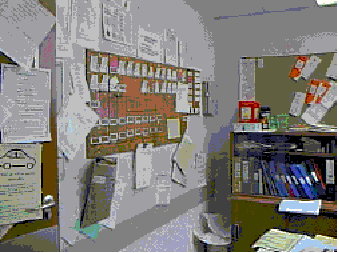
The key worker here is the Directorate Manager (DM). DMs are responsible for the day to day running of the wards and clinics within a hospital directorate e.g. orthopaedics. DMs have responsibilities across three separate hospital sites that make up one hospital Trust. The focus is on the activity of doing a walkabout in order to establish the state of play in the directorate with regard to the availability of beds. This involves walking around the relevant wards to do a head count and then to check with other co-workers on any local information they may have that may be of use in establishing the state of play. It allows for ad hoc collaboration and sharing of knowledge between the DM and othhers e.g. ward manager, physiotherapist.
Although the activity 'doing a walkabout' has no specific representation or recording there is a represenation of what is being established, i.e.bed availability. This is on what is known as the beds board. See 3 below (and public artefact (PublicDisplayedArtefact)). There is also a representation of what has necessitated the 'walkabout', in the form of a printout from the Management Information System (MIS). The printout is the end of day report, which is a daily report sent from the Bed Manager to all DMs, and shows details of the current beds availability. It may be inaccurate for a number of reasons. The activity that the walkabout produces, i.e. a more accurate measure of bed availability, is not given formal representation. The lack of direct representation of this outcome is not seen to be problematic, but it is important to acknowledge the activity as being important.

The bed board represented the total ward area, with each ward bay (usually comprising six beds) marked separately. Each bed is represented by a metal slot where a card, with the patients details, can be placed. Cards that have been placed straight into the slots represent existing in-patients. Cards placed diagonally in the slots represent patients due to be discharged, pending a visit by social services, a consultant, the physiotherapist etc. The presence of diagonally-placed cards forced an immediate re-count for the DM, as her count was based on a head-count of patients present. The DM then discussed available beds with the ward sister, who explained the expected time/date of discharge for the diagonals. The ward sister also pointed to two cards for existing in-patients and explained that they were acutely, terminally ill but said that she couldnt guarantee a day or time for them. The DM then left the nurses station and went to speak to the physiotherapist to ascertain whether there were any other patients who were fit for discharge or who were likely to become so that day. Through these processes, the DM established that there were enough beds to see them through the crisis. On leaving the ward area, the DM said that establishing the availability of beds is a very physical thing.
The activity itself facilitates coordination in various ways. It is described as being fairly directed, with the DM describing her actions as going through the usual rituals. For example, the DM knows who are the key people to speak to establish a more accurate bed availability figure e.g the ward manager. Therefore the basis for co-ordination can be seeing one of these key personnel e.g. the physiotherapist who may be due to assess patients for discharge. Doing the walkabout allows the individual to negotiate interaction, establishing who is available for interaction and relevant the situation at hand. In this way particular people are sought out whenever this situation arises.
Inter-organisational group of workers within the hospital Trust (DM, ward manager, social services assessor), the activity of 'a walkabout' and the interaction it facilitates.